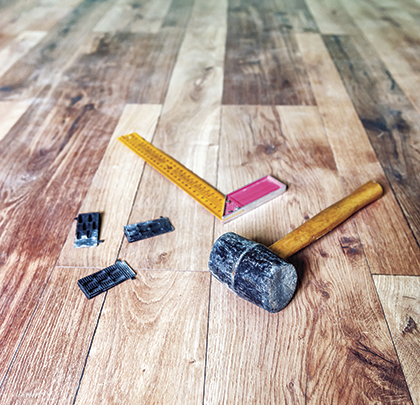Since its unveiling at a major flooring conference a few years ago, WPC has vastly become a rising star in the world of flooring. Short for wood plastic composite, WPC offers commercial facilities a wood resembling product that is durable, quiet under foot, waterproof, recyclable, and easy to maintain. To get more familiar with WPC, let’s get you started with a few answers to some important questions.
HOW IS WPC CONSTRUCTED?
Although the “W” in WPC stands for wood, this type of flooring doesn’t actually contain wood in the traditional sense. It is, however, a composite material that is made up of a combination of wood flour or fibers and heated thermoplastic resins. Together, these materials surpass other conventional types of vinyl flooring regarding care, durability, and water resistance. WPC is typically comprised of four layers:
Wear Layer: Just like traditional vinyl flooring, this layer is designed to protect your flooring from dents, scuffs, and scratches. It comes in different ranges of thickness; therefore, the thicker the wear layer, the more durable the flooring will be.
Printed Top Layer: This layer is where the “W” in WPC gets its credibility. By using 3D printing technology, the printed top layer adds depth and realism that one might see in classic wood floors.
Core Layer: The core layer is where you get the most “bang” for your buck. Here, you will find a high density, yet stable waterproof center that will not expand, contract, swell, or peel when faced with liquid, standing water, or any other type of moisture.
Backing Layer: Otherwise known as the flooring’s backbone, this layer provides your planks with added sound insulation, as well as being naturally resistant to mold and mildew.
DISTINCT ADVANTAGES OVER LAMINATE?
One distinct advantage that WPC has over laminate flooring is that WPC is 100-percent waterproof. This means that WPC can go places that laminate should not—typically in spaces such as bathrooms, kitchens, and areas below ground level. Easy installation is also an advantage that WPC has over laminate. Laminate requires more surface preparation as it tends to reflect and amplify any imperfections in the subfloor. WPC, however, typically implements glueless locking systems which are easier to install, while also preventing slippage and separation. If laminate is still something you want to incorporate within your facility, check out waterproof laminate flooring.
HOW DOES IT DIFFER FROM LVT?
Here is where things get a little complicated. WPC is often marketed as LVT (luxury vinyl tile)—even though WPC is a plastic-based product and LVT is primarily vinyl. The reasoning is that LVT is one of the most popular and renowned flooring options available on the market today. Therefore, pitching WPC as a luxury vinyl product makes sense when referring to marketable. Think about it like this, if you were to create a new style of pizza and go out and sell them yourself, you might find it difficult to make ends meet. However, if you were able to get a famous restaurant to market your product, your pizza might become world famous. This is the hope with WPC. Even though it is still relatively new and unknown, WPC has all the capabilities of becoming the next big thing in the flooring industry. ■
About the Author:
Mitchell Bryant is the communications specialist at Spectra Contract Flooring, the largest commercial flooring contractor in the U.S. For more information, visit www.spectracf.com.
_________________________________________________________________________
Modern Contractor Solutions, July 2017
Did you enjoy this article?
Subscribe to the FREE Digital Edition of Modern Contractor Solutions magazine.

WPC: The Next Big Thing in the Flooring Industry?


